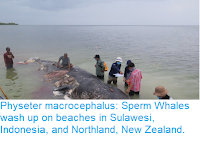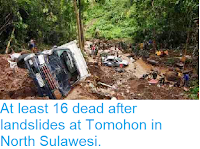Nine miners have been confirmed dead and several dozen more are thought to be trapped below ground following a collapse at an unlicensed gold mine in the Bolaang Mongondow District of North Sulawesi Province, Indonesia, on Tuesday 26 February 2019. About sixy miners were thought to have been below ground at the time of the incident, with nineteen miners having been rescued so far, sixteen of whom are being treated at a local hospital for a variety of injuries, with three having been transferred to larger hospital outside of the district for more serious problems; one of these miners is reported to have suffered a broken spine. The mine is reported to be located on an unstable slope, with further landslips hampering rescue attempts.
Rescue workers removing a body from the scene of a mine collapse in North Sulawesi this week. Xinhua.
Indonesia's large size, mineral richness, and poor population make unlicensed mining a widespread problem in the country, with illegal mines typically dug with hand tools and located in remote locations where authorities are unlikely to spot them (though some such operations are larger and more blatant in nature). Such mines tend to take few health and safety precautions, and are often dug by people with only a limited understanding of the structural geology of the area, making accidents extremely common, in many cases without help ever arriving due to the hidden nature of the mines. Such mines also present an environmental threat, producing waste which is often toxic, and contributing to deforestation, which can destabilise hillslopes, placing the miners at further risk.
See also...
Follow Sciency Thoughts on Facebook.







